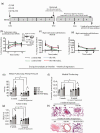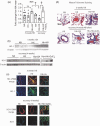Evidence supporting a role for circulating macrophages in the regression of vascular remodeling following sub-chronic exposure to hemoglobin plus hypoxia
- PMID: 34777787
- PMCID: PMC8573496
- DOI: 10.1177/20458940211056806
Evidence supporting a role for circulating macrophages in the regression of vascular remodeling following sub-chronic exposure to hemoglobin plus hypoxia
Erratum in
-
Corrigendum for Evidence supporting a role for circulating macrophages in the regression of vascular remodeling following sub-chronic exposure to hemoglobin plus hypoxia.Pulm Circ. 2021 Dec 13;11(4):20458940211068399. doi: 10.1177/20458940211068399. eCollection 2021 Oct-Dec. Pulm Circ. 2021. PMID: 34925764 Free PMC article.
Abstract
Macrophages are a heterogeneous population with both pro- and anti-inflammatory functions play an essential role in maintaining tissue homeostasis, promoting inflammation under pathological conditions, and tissue repair after injury. In pulmonary hypertension, the M1 phenotype is more pro-inflammatory compared to the M2 phenotype, which is involved in tissue repair. The role of macrophages in the initiation and progression of pulmonary hypertension is well studied. However, their role in the regression of established pulmonary hypertension is not well known. Rats chronically exposed to hemoglobin (Hb) plus hypoxia (HX) share similarities to humans with pulmonary hypertension associated with hemolytic disease, including the presence of a unique macrophage phenotype surrounding distal vessels that are associated with vascular remodeling. These lung macrophages are characterized by high iron content, HO-1, ET-1, and IL-6, and are recruited from the circulation. Depletion of macrophages in this model prevents the development of pulmonary hypertension and vascular remodeling. In this study, we specifically investigate the regression of pulmonary hypertension over a four-week duration after rats were removed from Hb + HX exposure with and without gadolinium chloride administration. Withdrawal of Hb + HX reversed systolic pressures and right ventricular function after Hb + Hx exposure in four weeks. Our data show that depleting circulating monocytes/macrophages during reversal prevents complete recovery of right ventricular systolic pressure and vascular remodeling in this rat model of pulmonary hypertension at four weeks post exposure. The data presented offer a novel insight into the role of macrophages in the processes of pulmonary hypertension regression in a rodent model of Hb + Hx-driven disease.
Keywords: heart; hemoglobinopathies; lung; pulmonary vascular disease; sickle cell disease.
© The Author(s) 2021.
Figures




Similar articles
-
An Hb-mediated circulating macrophage contributing to pulmonary vascular remodeling in sickle cell disease.JCI Insight. 2019 Aug 8;4(15):e127860. doi: 10.1172/jci.insight.127860. eCollection 2019 Aug 8. JCI Insight. 2019. PMID: 31391342 Free PMC article.
-
Hemoglobin-induced lung vascular oxidation, inflammation, and remodeling contribute to the progression of hypoxic pulmonary hypertension and is attenuated in rats with repeated-dose haptoglobin administration.Free Radic Biol Med. 2015 May;82:50-62. doi: 10.1016/j.freeradbiomed.2015.01.012. Epub 2015 Feb 2. Free Radic Biol Med. 2015. PMID: 25656991 Free PMC article.
-
Immunoregulatory macrophages modify local pulmonary immunity and ameliorate hypoxic-pulmonary hypertension.bioRxiv [Preprint]. 2023 Aug 2:2023.07.31.551394. doi: 10.1101/2023.07.31.551394. bioRxiv. 2023. Update in: Arterioscler Thromb Vasc Biol. 2024 Dec;44(12):e288-e303. doi: 10.1161/ATVBAHA.124.321264. PMID: 37577587 Free PMC article. Updated. Preprint.
-
Injury-Induced Shedding of Extracellular Vesicles Depletes Endothelial Cells of Cav-1 (Caveolin-1) and Enables TGF-β (Transforming Growth Factor-β)-Dependent Pulmonary Arterial Hypertension.Arterioscler Thromb Vasc Biol. 2019 Jun;39(6):1191-1202. doi: 10.1161/ATVBAHA.118.312038. Arterioscler Thromb Vasc Biol. 2019. PMID: 30943774 Free PMC article.
-
The role of inflammation in hypoxic pulmonary hypertension: from cellular mechanisms to clinical phenotypes.Am J Physiol Lung Cell Mol Physiol. 2015 Feb 1;308(3):L229-52. doi: 10.1152/ajplung.00238.2014. Epub 2014 Nov 21. Am J Physiol Lung Cell Mol Physiol. 2015. PMID: 25416383 Free PMC article. Review.
Cited by
-
Targeting lung heme iron by aerosol hemopexin adminstration in sickle cell disease pulmonary hypertension.Free Radic Biol Med. 2025 Mar 1;229:458-473. doi: 10.1016/j.freeradbiomed.2025.01.045. Epub 2025 Jan 23. Free Radic Biol Med. 2025. PMID: 39862998
-
The Role of Inflammation in The Cellular and Molecular Mechanisms of Cardiopulmonary Complications of Sickle Cell Disease.Biomolecules. 2023 Feb 17;13(2):381. doi: 10.3390/biom13020381. Biomolecules. 2023. PMID: 36830749 Free PMC article. Review.
-
Immunoregulatory Macrophages Modify Local Pulmonary Immunity and Ameliorate Hypoxic Pulmonary Hypertension.Arterioscler Thromb Vasc Biol. 2024 Dec;44(12):e288-e303. doi: 10.1161/ATVBAHA.124.321264. Epub 2024 Oct 10. Arterioscler Thromb Vasc Biol. 2024. PMID: 39387119
References
-
- Tuder RM, Stacher E, Robinson J, et al.. Pathology of pulmonary hypertension. Clin Chest Med 2013; 34: 639–650. - PubMed
-
- Rother RP, Bell L, Hillmen P, et al.. The clinical sequelae of intravascular hemolysis and extracellular plasma hemoglobin: a novel mechanism of human disease. JAMA 2005; 293: 1653–1662. - PubMed
Grants and funding
LinkOut - more resources
Full Text Sources

